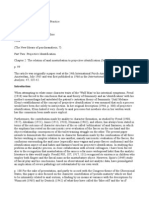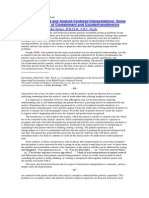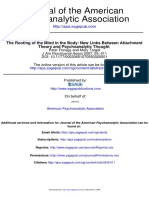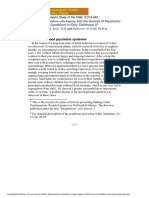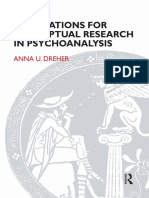0 ratings0% found this document useful (0 votes)
212 viewsBornstein, B. - On Latency
Bornstein, B. - On Latency
Uploaded by
cabaretdadaThis document discusses the psychoanalytic concept of latency in children ages 5-10. It describes how during early latency from ages 5-8, children experience strong conflicts between their ego, id, and newly formed superego. Symptoms like anxiety and insomnia can arise as defenses form. Children are aware of emotional distress and may be open to analysis. In later latency from 8-10, conflicts decrease as sexual demands lessen and the superego becomes less rigid. Children consolidate defenses and focus more on reality. They resist analysis due to a fear of disrupting their fragile equilibrium.
Copyright:
© All Rights Reserved
Available Formats
Download as PDF, TXT or read online from Scribd
Bornstein, B. - On Latency
Bornstein, B. - On Latency
Uploaded by
cabaretdada0 ratings0% found this document useful (0 votes)
212 views8 pagesThis document discusses the psychoanalytic concept of latency in children ages 5-10. It describes how during early latency from ages 5-8, children experience strong conflicts between their ego, id, and newly formed superego. Symptoms like anxiety and insomnia can arise as defenses form. Children are aware of emotional distress and may be open to analysis. In later latency from 8-10, conflicts decrease as sexual demands lessen and the superego becomes less rigid. Children consolidate defenses and focus more on reality. They resist analysis due to a fear of disrupting their fragile equilibrium.
Original Description:
texto acerca de la latencia
Original Title
Bornstein, B. - On latency
Copyright
© © All Rights Reserved
Available Formats
PDF, TXT or read online from Scribd
Share this document
Did you find this document useful?
Is this content inappropriate?
This document discusses the psychoanalytic concept of latency in children ages 5-10. It describes how during early latency from ages 5-8, children experience strong conflicts between their ego, id, and newly formed superego. Symptoms like anxiety and insomnia can arise as defenses form. Children are aware of emotional distress and may be open to analysis. In later latency from 8-10, conflicts decrease as sexual demands lessen and the superego becomes less rigid. Children consolidate defenses and focus more on reality. They resist analysis due to a fear of disrupting their fragile equilibrium.
Copyright:
© All Rights Reserved
Available Formats
Download as PDF, TXT or read online from Scribd
Download as pdf or txt
0 ratings0% found this document useful (0 votes)
212 views8 pagesBornstein, B. - On Latency
Bornstein, B. - On Latency
Uploaded by
cabaretdadaThis document discusses the psychoanalytic concept of latency in children ages 5-10. It describes how during early latency from ages 5-8, children experience strong conflicts between their ego, id, and newly formed superego. Symptoms like anxiety and insomnia can arise as defenses form. Children are aware of emotional distress and may be open to analysis. In later latency from 8-10, conflicts decrease as sexual demands lessen and the superego becomes less rigid. Children consolidate defenses and focus more on reality. They resist analysis due to a fear of disrupting their fragile equilibrium.
Copyright:
© All Rights Reserved
Available Formats
Download as PDF, TXT or read online from Scribd
Download as pdf or txt
You are on page 1of 8
The Psychoanalytic Study of the Child
ISSN: 0079-7308 (Print) 2474-3356 (Online) Journal homepage: http://www.tandfonline.com/loi/upsc20
On Latency
Berta Bornstein
To cite this article: Berta Bornstein (1951) On Latency, The Psychoanalytic Study of the Child, 6:1,
279-285, DOI: 10.1080/00797308.1952.11822916
To link to this article: https://doi.org/10.1080/00797308.1952.11822916
Published online: 13 Feb 2017.
Submit your article to this journal
Article views: 1
View related articles
Citing articles: 17 View citing articles
Full Terms & Conditions of access and use can be found at
http://www.tandfonline.com/action/journalInformation?journalCode=upsc20
ON LATENCyl
By BERTA BORNSTEIN (New York)
From the standpoint of the intellectual ability of the child in
latency, we could expect the child to associate freely. The factors re-
sponsible for the child's failure to do so create a general limitation of
child analysis. There are several reasons for his inability to associate. In
addition to those well known to us, I will mention only one which has
not been: stressed yet: Free association is experienced by the child as a
particular threat to his ego organization.
The use of free association is actually a regression to the primary
process. In early latency the child is still close to the period when his
mind was mainly dominated by the pleasure-principle and conscious
and unconscious contents were not yet strictly separated. It is only with
great difficulty that the child learns that contradictions exclude each
other and that contradictory thoughts must be kept apart in conversa-
tion.
For the sake of adults, the child behaves as though he were living
by the rules of the secondary process. However, listening to children
five to eight years old, when they are engaged in conversations with
each other, convinces us that conscious production does not necessarily
mean constant utilization of the secondary process. Their conscious
. thought processes (on the surface similar to ours) can during the latency
period still easily dip into the primary process. Any newly acquired ac-
complishment can easily be undone by regressive processes and the
child senses that this would occur were he to attempt to express what-
ever comes into his mind. Therefore the child must fight against free
association more than the adult. A particularly strong anticathexis is
needed to safeguard the hardly achieved intactness of ego functioning.
Free association is possible only after children have gradually developed
the capacity for introspection. This hardly ever occurs before pre-
puberty when the superego approaches a state of consolidation.
Before we speak about latency and the technique applied during
that period, let me review briefly the main factors which precede latency.
1. Paper read at the Panel on Child Analysis. held at the Annual Meeting of the
American psychoanalytic Association in Cincinnati on May 5, 1951.
279
280 BERTA BORNSTEIN
The ego as a mediator between the inner and outer world adopts at an
early point defensive measures against painful stimuli from within
and without. Under the influence of reality, the ego is enabled gradually
to tolerate greater amounts of tension. The open pursuit of the child's
gratifications is hindered by the parents' opposition. The growing
functions of intellect and judgment assist the child further to postpone
gratifications and to block impulses from direct discharge. A partial
resolution of the oedipus complex leads, via the identification with the
objects of the oedipus complex, to the establishment of the superego.
From now on the ego has to observe not only the demands of instinctual
drives and of the outside world, but also the demands coming from the
superego. This means that certain demands which originally were only
complied with under the pressure of the parents or their substitutes, are
now complied with even if there is no threat of external danger.
With the resolution of the oedipus complex and with the estab-
lishment of the superego, the latency period is introduced. Although it
is common practice to refer to the latency period as if it were uniform,
at least two major divisions within it can be discerned; the first from
five and one half to eight years, and the second from eight until about
ten years. There are, of course, more than chronological differences be-
tween them. The element common to both is the strictness of the super-
ego in its evaluation of incestuous wishes-a strictness which finds ex-
pression in the child's struggle against masturbation.
Let me now describe the characteristics of the first period of latency.
The ego, still buffeted by the surging impulses, is threatened by the new
superego which is not only harsh and rigid but still a foreign body.
This first phase of latency is complicated because of the intermingling
of two different sets of defenses: the defense against genital and the de-
fense against pregenital impulses. As a defense against genital impulses
a temporary regression to pregenitality is adopted by the ego. First these
pregenital drives appear as less dangerous than the genital ones. Still
they are threatening enough for the child to have to evolve new de-
fenses against the pregenital impulses. Reaction formations, developed
as defense against the pregenital impulses, mark the first character
changes in early latency.
The result of the conflicts between the superego and the drives can
be observed in a heightened ambivalence. This increased ambivalence
is a regular feature of early latency, even if the child is not in the
process of developing an obsessive neurosis. The ambivalence is ex-
pressed in the child's behavior by an alternation between obedience and
rebellion: and rebellion is usually followed by self-reproach. However,
ON LATENCY 281
at this time of life, the child can tolerate his own feelings of guilt as
little as he can tolerate criticism from the outside, nor is his behavior
modified right away by either. Anna Freud has described what happens at
"this intermediate stage of superego development": The attempt to
internalize the criticism from the outside sometimes does not lead
further than to an identification with the aggressor, "often supple-
mented by another defensive measure, namely the projection of guilt."
Both defenses in turn thrust the child into greater inner and outer
conflicts.
It appears to me that the statement frequently made that infantile
neurosis decreases during latency requires some modification. It is cor-
rect as far as the second period is concerned, but it does not correspond
to my own experience as far as the first period is concerned. When the
ego is faced by conflicts it cannot overcome during the first period
behavior difficulties arise and neurotic symptoms manifest themselves
in new ways. To give a few examples: Early animal phobias are re-
placed by a new wave of separation anxiety and open castration fear is
substituted by fear of death. The symptom of insomnia occurs more
frequently during that period than is generally known.
Some children in early latency give the appearance of being in an
emergency situation; they are conscious of their emotional distress and
under such conditions they are ready to accept the analyst as a potential
helper. Though they usually expect instantaneous relief and become
disappointed and distrustful if this does not occur, they can be very
co-operative during treatment. Due to the facts that the child is aware
of his suffering, that the ego is in rebellion against both id and super-
ego, that the libido is still in a fluid state and the superego still open to
modification, and thus that the ego is not yet completely crippled by
neurotic defenses, therapeutic chances seem to be better in early
latency than at any other time.
In the second period of latency the situation is different: The ego
is exposed to less severe conflicts by virtue of the facts that, on the one
hand, the sexual demands have become less exerting and, on the other,
the superego has become less rigid. The ego now can devote itself to a
greater extent to coping with reality. The average eight-year-old is
ready to be influenced by the children around him and by adults other
than his parents. As he is able to compare them with other adults, his
belief in the omnipotence of his parents subsides. Coinciding with a
partial degradation of parents, there is a parallel change in the attitude
of the ego toward the superego.
Even if this period is not quite as smooth as described, even if
282 BEllT A BORNSTEIN
children manifest character disturbances, ego restrictions or slight ob-
sessive symptoms, these symptoms are ego-syntonic.
During the second period, the temptation to masturbate is not
completely overcome but the child is so sincerely opposed to the temp-
tation as well as to the occasional break-throughs, that he must deny
or repress both. His concern to forego the masturbatory temptations is
accompanied by the desire that defenses should not be upset by any
interference. Since he is further along in the process of consolidation
of ego defenses than the younger latency child, and is more oriented to
coping with problems of the outside world, and since he has more
gratifications in reality, the older latency child is less aware of his suf-
fering.
He fears nothing more than the upsetting of his precarious equilib-
rium. The fear of upsetting this equilibrium becomes the decisive force
in his resistance toward analysis. The child's distrust of the enmity
toward the analyst is thus often a displacement of his enmity and dis-
trust of his instinctual impulses.
We repeat: during both periods of latency, neurotic children see
as a principle task the warding off of incestuous fantasies and mastur-
batory temptations. They accomplish this task by means of partial
regression. The ego during this period is engaged in deflecting the
sexual energy from its pregenital aims and is utilizing it for sublima-
tion and reaction formation. But in neither periods do they fully suc-
ceed and a close-up of this period shows the ego in a ceaseless, though
quickly repressed, battle against the temptation to masturbate. It ap-
pears to us that adult patients give a distorted picture of their latency.
They are inclined to remember this period as one in which they had
in reality attained what Freudt described as the ideal of latency: the suc-
cessful warding off of instinctual demands. The impression retained
of latency period is understandable when one takes into account with
what amazing rapidity (even in analysis) children repress or deny the
occasional breakthroughs of their masturbatory activities. The child's
behavior during the latency period might be described as one of per-
sistent denial of the struggle against the breakthrough of instinctual
impulses, a denial which extends into adulthood as a partial amnesia
for this period. This may be one of the reasons why one learns relatively
little about latency from the analysis of adults.s
The form of analytic technique with latency children must be in
2. "Three Contributions to the Theory of Sex," in The Basic Writings of Sig.
mund Freud, Modern Library. New YO!"k, 1938.
3. We find exceptions in those adults whose latency was disturbed by a severe
obsessive neurosis.
ON LATENCY 285
accordance with the specific characteristics of the psychic structure we
have just described. Because the child battles against his impulses and
needs to keep up his defenses, we must be particularly careful to respect
his resistance, and to work through his defenses before we approach the
material which is warded off. We know how difficult it is for a child in
latency to tell us anything about his inner life.
We have learned to utilize substitutes for free associations, such as
play, drawings and stories, which enable us to draw conclusions about
id contents, but unlike the adult's free association, these substitute
media do not, to the same extent, furnish material on defenses or their
genesis. Whatever these media represent, we do not use them for the
interpretation of id contents, but as a source of knowledge of the child,
and as a stepping stone toward the analysis of defense and of affects.
Since free association is not applicable in latency, defense analysis
is more complicated in the analysis of children than in that of an adult.
We are forced to search for defenses by microscopic observation of the
total behavior of the child.
So far my remarks were theoretical. Let me now turn to an example, Il-
lustrating the technique of defense analysis as it was employed in the handling
of a daydream a ten-year-old boy told during his treatment. The patient's char-
acter disturbance found expression in his complicated relationship with his
father and his brothers with whom he competed and toward whom he harbored
strong passive desires. Like most children he was apt to forget painful experi-
ences in reality.
His daydreams were important for us not only because they represented a
superstructure of a masturbatory fantasy. but because their appearance in the
analytic situation signaled a current humiliating experience and permitted the
reconstruction of his reaction to such experiences.
After a period of analysis in which we had worked on his desire to com-
pete with his father and his older brothers which at times had not led further
than to an identification with their gestures. he made a conscious effort to com-
bat his display of competition. At the beginning of his analysis, he openly played
at being important men like generals and admirals; now, in his daydreams, he
revealed a modification of these wishes. Motivated by the desire to please the
analyst, he made a strong point of telling me that in his daydream he himself
was a ten-year-old boy and that in reality he no longer sought to compete with
his father but wanted to remain a boy of his own age.
In his daydreams, however, young as he was, he was a famous brain surgeon,
and had also discovered a cure for cancer. He attended school during the day,
of course, but nevertheless General Eisenhower had heard that our patient was
a famous brain surgeon and ordered the boy night after night to the battle
field to perform his famous operations on outstanding generals. The brains of
those generals were shattered by bullets or their lives were endangered by brain
284 BERTA BORNSTEIN
tumors. It was through his restoring the generals' mental capacity that the
United States won the war.
Up to this point his daydream emphasized that nobody at school knew
about his fame as a brain surgeon. One day a variation of the daydream oc-
curred. A policeman entered the class room and asked about a car that was not
parked correctly. It turned out to be our patient's car; in this way everyone at
school suddenly learned that he not only had, as he said, a "doctor's certificate,"
but in recognition of his outstanding services, he had also been granted a
driver's license. Our knowledge of his tendencies to react to slight narcissistic
injuries with ideas of greatness made us inquire about a defeat at school. We
asked whether anything had happened at school, whether anyone had offended
him, etc. He told us,' though not immediately, that a man teacher had com-
mented on his continuous yawning during class and that it was at this moment
that his exhibitionism broke through in his daydream.
As we said before, our interest in a daydream is not aimed at im-
mediately reaching the masturbatory fantasy which it elaborates. What
we take out of it, is a knowledge of the typical defenses and the reac-
tion to affects. Although this would be true of almost any production
of the child, I have selected the daydream precisely because it is so close
to the unconscious; yet it should be used to deal with defense and affect
rather than with the instinctual impulses. Since defense and affect are
closer to the ego than the impulse, we are able, through them, to make
interpretations which the child can recognize and accept without undue
resistance. Once a defense appears, we can assume that it is typical for
particular situations, and that the identical affect or impulse is present
whenever the defense reappears. This being so, whenever a defense is
noticed, one can bring to the child's attention the event and the affect to
which he had reacted. What has been said about defenses applies in a
general way to affects. Wherever we observe an inappropriate expression
of affect, we can assume that the ego has intervened. As Anna Freud'
said: from the transformations which the affect has undergone, we can
deduce the specific defenses used against them and we can also assume
that the same defenses are used against the instinctual impulses which
originally gave rise to these affects.
Let us return to the daydream and scrutinize it from the standpoint
of defense and affect. Our young daydreamer, we have seen, reacted to
a painful reality situation by denial in fantasy. He was not the little boy
whom a teacher could scold, but an important surgeon who wielded the
power of life and death over the commanders of many men.
Another element in his reaction to the reprimand was a feeling of
shame. The shame could not be consciously admitted, because of its
•. The Ego and the Mechanisms of Defense. Int. Univ. Press, New York, 1946.
ON LATENCY 285
associative connection with his passivity. In his daydream, he reverses
the shame into glory. The shame was secret, the glory was public. When-
ever our patient used the mechanism of reversal, we were sure that be-
hind it was an instinctual impulse which clamored for discharge, and
against which the boy rebelled. For instance, the daydream in which
our patient performs nocturnal brain surgery on generals becomes mean-
ingful if understood as representing its opposite. You will not be sur-
prised to hear that the daydream took form in a period in which the
boy fought against his identification with women. His surgical activity,
and his removal of foreign bodies from the head, was the opposite of his
unconscious wish to be a woman who gives birth to a child,s
There were other affects involved which had to be examined. In a
school situation, in which a teacher reprimanded a pupil, we would
expect the child to experience some anger. This the child did not. No
anger had appeared. It was obvious that he consciously could not toler-
ate any aggression against men. In order to prevent the impulse from
appearing, the appropriate affect had to be repressed. Asked about how
he had really felt, the child answered good-humoredly: "I really was
'not angry, I had fun with my daydream. I would really like to become
a brain surgeon."
Some time after the boy spoke scornfully about his daydream:
"Gee, I'm really a fool, here I am talking about curing the generals
from brain tumors, and 1 don't even know anything about the brain,
how the nerves are working and the blood cells, and what makes the
heart beat, and what makes a man's muscles hard as bones."
His thirst for knowledge, the desire to learn about physiology and
anatomy, remained untouched by our analytic interpretation, although
they were rooted in the same conflicts that showed up in the daydream.
In concluding I should like to emphasize that I have discussed pri-
marily the neurotic child and his latency. All children in latency, how-
ever, not only the neurotic ones, use their free energies for character
development. Therefore it is particularly important during latency not
to interfere with healthy character formation. The utmost care has to
be exercised in the analysis of latency to strengthen weak structures and
to modify those which interfere with normal development. The selec-
tion of material for interpretation and the form of interpretation itself
must be geared to these ends.
5. This unconscious wish was interpreted in other connections.
You might also like
- The Nature of AimDocument51 pagesThe Nature of AimSajid Khan100% (1)
- Humour, by Terry EagletonDocument9 pagesHumour, by Terry Eagletonnick19990531No ratings yet
- Sharpe, E. - The Impatience of HamletDocument11 pagesSharpe, E. - The Impatience of HamletcabaretdadaNo ratings yet
- Context Clues PracticeDocument2 pagesContext Clues Practiceapi-29040702250% (2)
- Reichmann Transference Problems-1Document16 pagesReichmann Transference Problems-1Melissa ContrerasNo ratings yet
- Developmental Levels of Personality OrganizationDocument45 pagesDevelopmental Levels of Personality OrganizationMurathan BayramNo ratings yet
- Donald Meltzer Relation of Anal Masturbation To Projective IdentificationDocument10 pagesDonald Meltzer Relation of Anal Masturbation To Projective IdentificationKevin McInnes100% (2)
- Khan and Winnicott Poems and Other WorksDocument8 pagesKhan and Winnicott Poems and Other WorksAna Inés100% (1)
- O'Shaughnessy, E. (1992) - Enclaves and ExcursionsDocument8 pagesO'Shaughnessy, E. (1992) - Enclaves and ExcursionsJulián Alberto Muñoz FigueroaNo ratings yet
- Susanna Isaacs ElmhirstDocument14 pagesSusanna Isaacs Elmhirstkarine botelhoNo ratings yet
- Codex of The Deep SpireDocument21 pagesCodex of The Deep Spirecefop9100% (3)
- Little The Analyst Total Response To His Patient NeedsDocument25 pagesLittle The Analyst Total Response To His Patient NeedsDaniela AndronacheNo ratings yet
- Selected Papers of Karl AbrahamDocument536 pagesSelected Papers of Karl AbrahamJpildain1970No ratings yet
- Holding and Interpretation: Fragment of An Analysis: D. W. WinnicottDocument123 pagesHolding and Interpretation: Fragment of An Analysis: D. W. WinnicottGabriela CaltutNo ratings yet
- Ecopsychology: Another Legal Tool? Essay by Valerie HarmsDocument5 pagesEcopsychology: Another Legal Tool? Essay by Valerie Harmsvalerie802No ratings yet
- Narcissus On The TextDocument11 pagesNarcissus On The TextRheverie ChenNo ratings yet
- Steiner, J. (1994) - Patient-Centered and Analyst-Centered Interpretations. Some Implications of Containment and CountertransferenceDocument9 pagesSteiner, J. (1994) - Patient-Centered and Analyst-Centered Interpretations. Some Implications of Containment and CountertransferenceJulián Alberto Muñoz FigueroaNo ratings yet
- Birksted-Breen, D. (1996) - Phallus, Penis and Mental SpaceDocument7 pagesBirksted-Breen, D. (1996) - Phallus, Penis and Mental Spaceofanimenoch100% (1)
- Psychotherapeutic Strategies in The Latency YearsDocument590 pagesPsychotherapeutic Strategies in The Latency YearsCarmen SpirescuNo ratings yet
- Pontalis, J. B. (2014) - No, Twice NoDocument19 pagesPontalis, J. B. (2014) - No, Twice NocabaretdadaNo ratings yet
- Module PDFDocument124 pagesModule PDFhelloNo ratings yet
- Magagna, J. and Pepper Goldsmith, T. (2009) - Complications in The Development of A Female Sexual Identity.Document14 pagesMagagna, J. and Pepper Goldsmith, T. (2009) - Complications in The Development of A Female Sexual Identity.Julián Alberto Muñoz FigueroaNo ratings yet
- BionDocument14 pagesBiondraganNo ratings yet
- Little, M. - On Delusional TransferenceDocument6 pagesLittle, M. - On Delusional TransferencecabaretdadaNo ratings yet
- 6 Psychoanalytic Theory: Clues From The Brain: Commentary by Joseph LeDoux (New York)Document7 pages6 Psychoanalytic Theory: Clues From The Brain: Commentary by Joseph LeDoux (New York)Maximiliano PortilloNo ratings yet
- Jamieson Webster - Conversion Disorder - Listening To The Body in Psychoanalysis-Columbia University Press (2018)Document311 pagesJamieson Webster - Conversion Disorder - Listening To The Body in Psychoanalysis-Columbia University Press (2018)Karthik SamyNo ratings yet
- Mark Solms, "Freud" and Bullitt: An Unknown ManuscriptDocument36 pagesMark Solms, "Freud" and Bullitt: An Unknown ManuscriptJonathan100% (1)
- Mourning in Children A Theoretical Synthesis and Clinical ApplicationDocument8 pagesMourning in Children A Theoretical Synthesis and Clinical ApplicationGary FreedmanNo ratings yet
- Searles Autism and The Phase of TransitionDocument21 pagesSearles Autism and The Phase of TransitionTiberiu SNo ratings yet
- Chused Enact5Document7 pagesChused Enact5Sebastián Santa Cruz AusinNo ratings yet
- Lia Pistiner de Cortiñas - The Aesthetic Dimension of The MindDocument341 pagesLia Pistiner de Cortiñas - The Aesthetic Dimension of The Mindstephen fitzpatrickNo ratings yet
- What Is This Professor Freud Like - KoellreuterDocument140 pagesWhat Is This Professor Freud Like - KoellreuterJose MuñozNo ratings yet
- Psychoanalysis Historical OverviewDocument37 pagesPsychoanalysis Historical OverviewRobNo ratings yet
- Aron Atlas 2015 Generative EnactmentDocument18 pagesAron Atlas 2015 Generative Enactmentemilio laffeNo ratings yet
- Superego Transformations Through The Analyst's Capacity For ReverieDocument16 pagesSuperego Transformations Through The Analyst's Capacity For ReverieCarla SantosNo ratings yet
- Williams (1999) Non-Interpretive Mechanisms inDocument16 pagesWilliams (1999) Non-Interpretive Mechanisms inLoratadinaNo ratings yet
- Fonagy & Target-2008-The Rooting of The Mind in The BodyDocument47 pagesFonagy & Target-2008-The Rooting of The Mind in The BodyJuan Guillermo Manrique LopezNo ratings yet
- Eli ZaretskyDocument21 pagesEli ZaretskylauranadarNo ratings yet
- The Non-Transference Relationship in The Psychoanalytic SituationDocument26 pagesThe Non-Transference Relationship in The Psychoanalytic Situationmercedes3bNo ratings yet
- Briggs - Risk of SuicideDocument15 pagesBriggs - Risk of SuicideJulián Alberto Muñoz FigueroaNo ratings yet
- Bion - Attacks On LinkingDocument17 pagesBion - Attacks On LinkingUriel García VarelaNo ratings yet
- Erna and M. KleinDocument17 pagesErna and M. KleinMarcos KlipanNo ratings yet
- 1951 Searles Manifestations of IncorporationDocument31 pages1951 Searles Manifestations of IncorporationKevin McInnesNo ratings yet
- Martin S. Bergmann 2008 - The Mind Psychoanalytic Understanding Then and Now PDFDocument28 pagesMartin S. Bergmann 2008 - The Mind Psychoanalytic Understanding Then and Now PDFhioniamNo ratings yet
- Spitz, R. A. (1955) - The Primal CavityDocument27 pagesSpitz, R. A. (1955) - The Primal CavitycabaretdadaNo ratings yet
- I. Observation A. A Circumscribed Psychiatric Syndrome: Anaclitic Depression-An Inquiry Into The Genesis of PsychiatricDocument32 pagesI. Observation A. A Circumscribed Psychiatric Syndrome: Anaclitic Depression-An Inquiry Into The Genesis of PsychiatriclgrisaNo ratings yet
- O'Shaughnessy, E., Harrison, A. and Alvarez, A. (1999) - Symposium On FrustrationDocument17 pagesO'Shaughnessy, E., Harrison, A. and Alvarez, A. (1999) - Symposium On FrustrationJulián Alberto Muñoz Figueroa100% (1)
- Theories of ForgettingDocument2 pagesTheories of ForgettingShaniza Nizam100% (1)
- José Bleger, The Setting, and Psychoanalysis TodayDocument9 pagesJosé Bleger, The Setting, and Psychoanalysis Todayneculai.daniela78771No ratings yet
- GERSON 1996 Neutrality Resistance and Self-Disclosure in An Intersubjective PsychoanalysisDocument17 pagesGERSON 1996 Neutrality Resistance and Self-Disclosure in An Intersubjective PsychoanalysisVerinha CarvNo ratings yet
- Vejez Psychoanalytic Approach To Depression and DementiaDocument367 pagesVejez Psychoanalytic Approach To Depression and Dementiavcunado100% (1)
- Sklar Jonathan Landscapes Dark History Trauma PsychoanalysisDocument209 pagesSklar Jonathan Landscapes Dark History Trauma PsychoanalysisJaime DonosoNo ratings yet
- Pages From Between Reality and Fantasy Transitional Objects and Phenomena Grolnick Simon A. 1930 4Document19 pagesPages From Between Reality and Fantasy Transitional Objects and Phenomena Grolnick Simon A. 1930 4TiborNo ratings yet
- Narcissistic Disorders in Clinical Practice - Ronald BrittonDocument14 pagesNarcissistic Disorders in Clinical Practice - Ronald BrittonvgimbeNo ratings yet
- 1992 Hoffman Some Practical Implications of A Social Constructivist View of The Psychoanalytic+SituationDocument11 pages1992 Hoffman Some Practical Implications of A Social Constructivist View of The Psychoanalytic+SituationyaelfridNo ratings yet
- 10.4324 9780429474897 PreviewpdfDocument23 pages10.4324 9780429474897 PreviewpdfAngela Maria Jimenez UrregoNo ratings yet
- Modell, A.H. (1991) - A Confusion of Tongues or Whose Reality Is ItDocument8 pagesModell, A.H. (1991) - A Confusion of Tongues or Whose Reality Is ItCiprian JurmaNo ratings yet
- Psychoanalytic Infant ObservationDocument4 pagesPsychoanalytic Infant ObservationSergiuNo ratings yet
- International Journal of PsychoanalysisDocument323 pagesInternational Journal of PsychoanalysisMarcos Paulo ShiozakiNo ratings yet
- Lacan and Bion: Psychoanalysis and The Mystical Language of 'Unsaying'Document12 pagesLacan and Bion: Psychoanalysis and The Mystical Language of 'Unsaying'Robert deBruce100% (1)
- Psychoanalysis: Critical Conversations: Selected Papers by Arnold D Richards Volume 1From EverandPsychoanalysis: Critical Conversations: Selected Papers by Arnold D Richards Volume 1No ratings yet
- Sperling, M. (1967) - School Phobias PDFDocument28 pagesSperling, M. (1967) - School Phobias PDFcabaretdadaNo ratings yet
- Solms, M. (2018) - Extracts From The Revised Standard Edition of Freud's Complete Psychological WorksDocument48 pagesSolms, M. (2018) - Extracts From The Revised Standard Edition of Freud's Complete Psychological Workscabaretdada100% (1)
- Kelsen, H. - The Conception of The State and Social PsychologyDocument39 pagesKelsen, H. - The Conception of The State and Social PsychologycabaretdadaNo ratings yet
- Zetzel - The Good HystericDocument6 pagesZetzel - The Good Hystericcabaretdada100% (1)
- Ferenczi, S. - Gulliver PhantasiesDocument19 pagesFerenczi, S. - Gulliver PhantasiescabaretdadaNo ratings yet
- Conjetural 35Document144 pagesConjetural 35cabaretdadaNo ratings yet
- Pursuit of A Dream (Narrative Essay)Document1 pagePursuit of A Dream (Narrative Essay)Ericka Mae TayamoraNo ratings yet
- Objectives: Identify The Parts of Speech Determine The Part of Speech by Analyzing The Use of Those Words in SentencesDocument22 pagesObjectives: Identify The Parts of Speech Determine The Part of Speech by Analyzing The Use of Those Words in SentencesnikaNo ratings yet
- The Lady or The TigerDocument8 pagesThe Lady or The TigerMs. Sara VenegasNo ratings yet
- 1 Learn To Juggle PDFDocument98 pages1 Learn To Juggle PDFpadam bhandariNo ratings yet
- This Study Resource WasDocument3 pagesThis Study Resource WasSHIVANSH KHANNA 20212052No ratings yet
- A Sign Is Anything That Can Be Used To Tell A Lie - Umberto EcoDocument7 pagesA Sign Is Anything That Can Be Used To Tell A Lie - Umberto EcoShubhadip aichNo ratings yet
- Baym - Mindfully - ScrollingDocument10 pagesBaym - Mindfully - ScrollingLala MehdiyevaNo ratings yet
- l1 Special Topics in Sts - Information SocietyDocument51 pagesl1 Special Topics in Sts - Information SocietyEdreign Pete MagdaelNo ratings yet
- I. Jumble Letters: Personal Performance A. Knowledge B. ExperienceDocument2 pagesI. Jumble Letters: Personal Performance A. Knowledge B. Experiencejenzel a omapasNo ratings yet
- Recipe For SuccesDocument27 pagesRecipe For Successtefany alvarezNo ratings yet
- Media and Information Literate IndividualDocument17 pagesMedia and Information Literate IndividualvalienteazuelorheaNo ratings yet
- PHILO Lesson 8 (Group 5)Document2 pagesPHILO Lesson 8 (Group 5)LEONILA MIRANDANo ratings yet
- Election CDI - Ivon Mingashang - CV Abrégé - enDocument7 pagesElection CDI - Ivon Mingashang - CV Abrégé - enDokolo PatrickNo ratings yet
- Friedrich Nietzsche: By: Jordan Greenwood, Trinity Going, and Makenzie WhiteDocument12 pagesFriedrich Nietzsche: By: Jordan Greenwood, Trinity Going, and Makenzie WhitedronregmiNo ratings yet
- SDO1 PangasinanDocument1 pageSDO1 PangasinanKhrizzle Aglaia Vino100% (2)
- Srilanka Herostone PDFDocument6 pagesSrilanka Herostone PDFAnchal SharmaNo ratings yet
- Instant Download Self-Cultivation Philosophies in Ancient India, Greece, and China 1st Edition Christopher W. Gowans PDF All ChapterDocument64 pagesInstant Download Self-Cultivation Philosophies in Ancient India, Greece, and China 1st Edition Christopher W. Gowans PDF All Chapterjembersuppu100% (2)
- Psych 2 Test #1 Answer KeyDocument2 pagesPsych 2 Test #1 Answer KeyIqbal BaryarNo ratings yet
- What Is Satanism?Document2 pagesWhat Is Satanism?Tuana Deniz BozanNo ratings yet
- New Ontologies Reflections On Some RecenDocument25 pagesNew Ontologies Reflections On Some RecenJef ScabioNo ratings yet
- L'art Du Débat - Tle - Cours Langues, Littératures Et Cultures Étrangères Anglais - KartableDocument1 pageL'art Du Débat - Tle - Cours Langues, Littératures Et Cultures Étrangères Anglais - KartableMarianne HanaNo ratings yet
- Approaches of Study of Politics ScienceDocument2 pagesApproaches of Study of Politics ScienceAasish MajhiNo ratings yet
- English Grade 7 (Grammar Lesson) : I. ObjectiveDocument3 pagesEnglish Grade 7 (Grammar Lesson) : I. ObjectiveMarnie GodienesNo ratings yet
- Andrea Del Sarto E - ContentDocument13 pagesAndrea Del Sarto E - ContentAbu SiddiqNo ratings yet
- Very Short Introductions Available From Oxford PaperbacksDocument1 pageVery Short Introductions Available From Oxford PaperbacksLampardDanielNo ratings yet
- List - of - Works - by - Madhvacharya - WikipediaDocument4 pagesList - of - Works - by - Madhvacharya - Wikipediapatrick876No ratings yet






